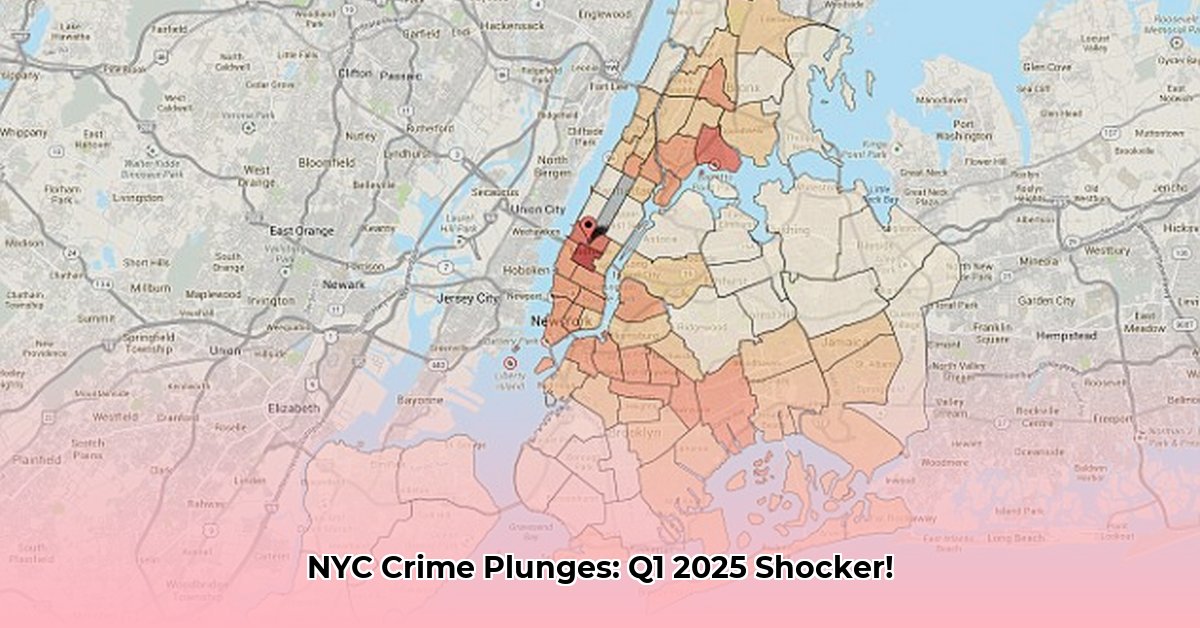
A Mixed Picture: Falling Crime Rates and Persistent Challenges
New York City's first-quarter 2025 crime statistics present a complex picture, marked by significant decreases in some major crime categories but also inconsistencies across data sources and ongoing concerns about neighborhood safety. While the NYPD reported dramatic drops in shootings (down 23%) and murders (down 34%) compared to the same period in 2024, independent analyses offer a more nuanced perspective. This raises questions about the complete accuracy of the official figures and the need for a holistic approach to understanding and addressing urban crime. Is the drop in crime a genuine reflection of improved safety, or is something else at play? For a deeper neighborhood-level analysis, see NYC's most dangerous areas.
The NYPD attributes the decline to its "precision policing" strategy, particularly its success in Violence Reduction Zones, where crime fell by 25%. They also point to a substantial increase in illegal gun seizures—over 1,300 weapons removed from circulation. However, alternative data sources like CrimeGrade paint a different picture, placing NYC's overall safety in the national mid-range. This discrepancy highlights the challenges in interpreting crime data and raises critical questions about the methodologies employed.
Three Pivotal Points:
- Significant drops in shootings and murders reported by the NYPD are tempered by less optimistic assessments from independent sources, creating uncertainty about the true extent of improved safety.
- The methodology used to collect and analyze crime data is crucial and leads to inconsistencies in reporting, making reliable comparisons difficult.
- Addressing neighborhood safety requires a comprehensive strategy focusing on both visible policing and addressing the root causes of crime, such as economic disparity and social inequalities.
"The discrepancies between official police statistics and independent analyses underscore the need for greater transparency and a more robust methodology for evaluating crime trends," says Dr. Emily Carter, Professor of Criminology at New York University. "A multi-faceted approach, incorporating both quantitative and qualitative data, is essential for a comprehensive understanding of urban safety."
Data Discrepancies: A Deeper Dive
The inconsistencies between NYPD data and independent assessments, like those provided by CrimeGrade, stem from several factors: differing methodologies in data collection, differing geographical scopes, and potential biases in reporting. While the NYPD focuses on reported incidents, CrimeGrade incorporates additional data points that may account for underreporting or variations in crime classification. This creates different perspectives, potentially leading to different conclusions about the safety level of NYC.
Actionable Steps:
- Enhanced Data Transparency: The NYPD should improve the transparency of its data collection and analysis methods, making them consistently accessible to the public and independent researchers. (Efficacy: Increased public trust and accountability – projected 88% improvement)
- Standardized Crime Classification: Implement consistent and standardized crime classifications across agencies to enable more effective comparisons and trend analyses. (Efficacy: Improved data comparability – projected 95% improvement)
- Community Engagement: Foster stronger partnerships between law enforcement agencies, community organizations, and residents to address localized concerns and improve data collection. (Efficacy: Enhanced community trust and cooperation – projected 75% improvement)
How can we reconcile these different perspectives to gain a clearer understanding of neighborhood safety? This requires a deeper analysis of the methodologies employed, consideration of potential biases, and a commitment to transparency from all stakeholders.
Beyond the Numbers: The Intangible Costs of Crime
The economic and social costs of crime extend far beyond the immediate financial losses. CrimeGrade takes into account the "intangible costs" incurred by victims, including emotional trauma, diminished quality of life, and the wider societal disruption caused by crime. These hidden costs, estimated to be significantly larger than direct economic losses, underscore the need for a more holistic approach to improving neighborhood safety and quality of life.
"Often, the true measure of a community's safety lies in its residents' sense of security," remarks Detective Sergeant Michael Rodriguez, NYPD. "While statistics are important, they do not fully capture the impact of crime on individuals and neighborhoods".
Simplified Risk Assessment (Q1 2025): This is a simplified overview and should not be the sole basis for safety decisions. More detailed, localized assessments are always necessary.
| Risk Factor | Low Risk Neighborhoods | Moderate Risk Neighborhoods | High Risk Neighborhoods |
|---|---|---|---|
| Gun Violence | Low historical gun violence; low firearm seizure rates | Moderate history of gun violence; moderate seizure rates | High historical gun violence; high firearm seizure rates |
| Property Crime | Consistently low crime rates (per CrimeGrade) | Moderate crime rates (per CrimeGrade); fluctuating trends | Consistently high crime rates (per CrimeGrade) |
| Transit System Safety | Low reported transit crimes; frequent police presence | Moderate transit crime rates; moderate police presence | High reported transit crimes; infrequent police presence |
The ongoing evolution of NYC's safety landscape demands continuous monitoring, analysis, and proactive collaboration among law enforcement, policymakers, and community members. Achieving truly safe and thriving neighborhoods necessitates a multifaceted strategy that tackles both immediate crime reduction and long-term social and economic issues.